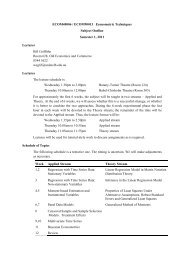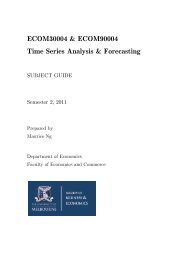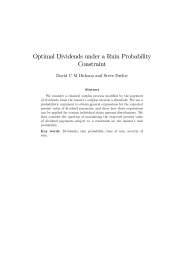A Model of Optimal Corporate Bailouts - Faculty of Business and ...
A Model of Optimal Corporate Bailouts - Faculty of Business and ...
A Model of Optimal Corporate Bailouts - Faculty of Business and ...
Create successful ePaper yourself
Turn your PDF publications into a flip-book with our unique Google optimized e-Paper software.
intentions, government intervention can exacerbate moral hazard: First, bailouts reduce theincentives <strong>of</strong> both firms <strong>and</strong> managers to avoid insolvency. Second, financing a bailout throughtaxation reduces pr<strong>of</strong>its, which reduces real wages <strong>and</strong> thus efficient managerial effort. Inour model (as well as in practice), government-introduced moral hazard severely limits thegovernment’s ability to intervene benevolently. We show that the distortions can be so largethat they prevent an efficient bailout even though it would be socially preferable for the firm tocontinue.Yet at the same time, moral-hazard concerns do not preclude the possibility <strong>of</strong> efficientbailouts altogether. To the contrary, we derive conditions under which bailouts are not onlyfeasible but also welfare enhancing. In this sense, our model can formalize—<strong>and</strong> in someways mediate—the debate between proponents <strong>of</strong> bailouts (who emphasize the social costs <strong>of</strong>allowing firms to fail), <strong>and</strong> opponents (who emphasize the moral hazard <strong>and</strong> efficiency losses<strong>of</strong> government intervention). Partially agreeing with the former, we argue that bailouts aresometimes both feasible <strong>and</strong> justified on efficiency grounds. Partially agreeing with the latter,we show that even when it would be socially optimal to keep a firm alive, moral-hazard issuescan make the cure worse than the disease.In addition to characterizing when an efficiency-enhancing bailout exists, we are alsointerested in its core terms <strong>and</strong> attributes. As already noted, our government is quite limited.It can tax the pr<strong>of</strong>its <strong>of</strong> some or <strong>of</strong> all firms; it can impose extraordinary taxes on bailed-outcompanies that succeed later; it can decide whether to bailout firms <strong>and</strong> on the amount <strong>of</strong>the bailout; <strong>and</strong>, if it does bailout firms, it can fire or keep the incumbent manager, <strong>and</strong> it caneliminate or retain existing owners. In our model, incumbent owners bring no special expertiseto the table that other owners could not provide, so the optimal government bailout eithersqueezes them out entirely or leaves them with no economic rents going forward. Similarly,the government can elicit more effort from managers prior to financial distress by insisting onpunishing (firing) the manager when a bailout is required. When incumbent managers—theones that have driven the firm into distress—do not have significant firm-specific skills, thisimproves their ex-ante incentives <strong>and</strong> is thus the optimal government bailout policy.We further show that financing an optimal bailout in our model is generally best done usinga redistributive tax. That is, an optimal bailout generally does not impose an extraordinary tax(or its functional equivalent) on rescued firms to contribute to their own bailouts out <strong>of</strong> futurepr<strong>of</strong>its. Rather, it taxes all firms when they are not in need <strong>of</strong> a bailout, <strong>and</strong> subsidizes bailoutrecipients with few/no financial strings attached. This is because the government alreadyfully expropriates existing owners <strong>and</strong> managers. Taxes levied ex post against (new) bailoutrecipients must in effect be “priced” into the governmental subsidy. And because such taxesinefficiently distort incentives, the government is better <strong>of</strong>f imposing lower extraordinary taxes(<strong>and</strong> thus paying a smaller bailout subsidy) instead.4
















